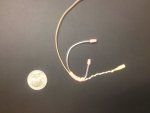Re: Theatrical Mic Attachment
Having done live sound for local concerts/performances, etc. since the 90's recently I had the opportunity to sub as the (vocal/voice) sound-tech for one performance of a local HS musical "Wizard of Oz". The gig went well...although I felt a bit weird giving the "lion" a condom (yes, giving a condom to a male HS student....) as his costume is HOT/SWEATY to put his wireless body-pack in... A veteran tech friend of mine had me fill-in as he triple-booked himself...
BTW: the HS owns all 12 wireless mics...(....about 8-12 year old units....sounded good....I did not check the frequency, no....but I AM curious...)
There were a couple of actresses that put their mics on backwards thus I had to boost the highs a bit...not a biggie..
The kids used skin-toned medical tape (from Walgreens) to secure their mics.
Best, Mike M
Having done live sound for local concerts/performances, etc. since the 90's recently I had the opportunity to sub as the (vocal/voice) sound-tech for one performance of a local HS musical "Wizard of Oz". The gig went well...although I felt a bit weird giving the "lion" a condom (yes, giving a condom to a male HS student....) as his costume is HOT/SWEATY to put his wireless body-pack in... A veteran tech friend of mine had me fill-in as he triple-booked himself...
BTW: the HS owns all 12 wireless mics...(....about 8-12 year old units....sounded good....I did not check the frequency, no....but I AM curious...)
There were a couple of actresses that put their mics on backwards thus I had to boost the highs a bit...not a biggie..
The kids used skin-toned medical tape (from Walgreens) to secure their mics.
Best, Mike M

